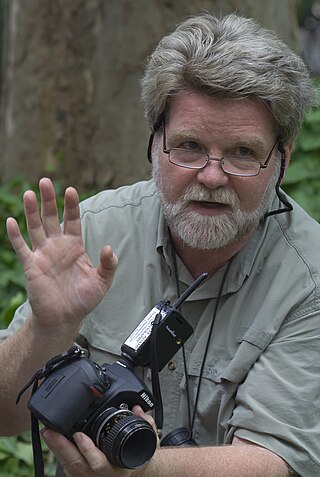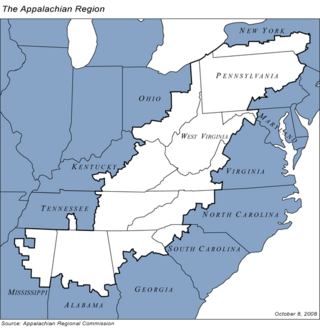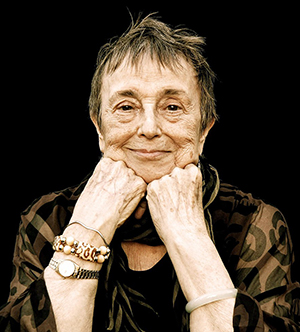Related Research Articles
Verna Mae Slone was an Appalachian author from Knott County, Kentucky.

The Museum of Appalachia, located in Norris, Tennessee, 20 miles (32 km) north of Knoxville, is a living history museum that interprets the pioneer and early 20th-century period of the Southern Appalachian region of the United States. Recently named an Affiliate of the Smithsonian Institution, the museum is a collection of more than 30 historic buildings rescued from neglect and decay and gathered onto 63 acres (25 ha) of picturesque pastures and fields. The museum also preserves and displays thousands of authentic relics, maintains one of the nation's largest folk art collections, and hosts performances of traditional Appalachian music and annual demonstrations by hundreds of regional craftsmen.

Elinor Carucci is an Israeli-American Fine Art Photographer of a North-African and Bukhari descent. She is based in New York City.

Zoe Strauss is an American photographer and a nominee member of Magnum Photos. She uses Philadelphia as a primary setting and subject for her work. Curator Peter Barberie identifies her as a street photographer, like Walker Evans or Robert Frank, and has said "the woman and man on the street, yearning to be heard, are the basis of her art."
Carrie Mae Weems is an American artist working in text, fabric, audio, digital images and installation video, and is best known for her photography. She achieved prominence through her early 1990s photographic project The Kitchen Table Series. Her photographs, films and videos focus on serious issues facing African Americans today, including racism, sexism, politics and personal identity.

Shelby Lee Adams is an American environmental portrait photographer and artist best known for his images of Appalachian family life.

Appalachia is a region of the Eastern United States. Home to over 25 million people, the region includes mountainous areas of 13 states: Mississippi, Alabama, Pennsylvania, New York, Georgia, South Carolina, North Carolina, Tennessee, Virginia, Kentucky, Ohio, Maryland, as well as the entirety of West Virginia.

Henry Horenstein is an American artist, photographer, filmmaker and educator. He is the author of over 35 books, including a series of instructional textbooks.

Anne Wilkes Tucker is an American retired museum curator of photographic works. She retired in June 2015.

Appalachian Americans or simply Appalachians describes Americans living in the geocultural area of Appalachia in the eastern United States, or their descendants

Ancella Radford Bickley is an American historian born in Huntington, West Virginia on July 4, 1930. She earned a bachelor's degree in English from West Virginia State College, now West Virginia State University in 1950, a master's degree in English from Marshall University in 1954, and an Ed.D. in English from West Virginia University in 1974. She is involved in the preservation of African American history in West Virginia.
Rob Amberg is a North Carolina photographer, folklorist, and chronicler of a small Madison County mountain community, Revere, North Carolina, which he depicted in his long-term photo project Sodom Laurel Album. Amberg anticipated the completion of highway I-26 from Charleston, South Carolina, to the Tennessee Tri-Cities area and, starting in 1994, began photographing, interviewing, and collecting objects to document the cutting of a nine-mile stretch of I-26 through some of North Carolina's most spectacular vistas and some of the world's oldest mountains—a project which contributed to the publication of his book The New Road. His documentary photography is archived in a collection at Duke University Library.

Kenneth Randall Light is an American social documentary photographer based in the San Francisco Bay Area. He is the author of twelve monographs, including Midnight La Frontera, What'sGoing On? 1969-1974,Delta Time, TexasDeath Row and, most recently, Course of the Empire, published by Steidl. He wrote Witness in our Time: Working Lives of Documentary Photographers, a collection of recollections and interviews with 29 of the world's most well-known photographers, editors and curators of the genre. He has had his photographs included as part of photo essays and portfolios in newspapers, magazines and other media, has been exhibited worldwide and is part of museum collections such as SF Museum of Modern Art and International Center of Photography. Light was also a co-founder of Fotovision, the Mother Jones International Fund for Documentary Photography and he is the recipient of a Guggenheim Fellowship and three National Endowment for the Arts photography fellowships. He is also a professor at the Graduate School of Journalism at UC Berkeley where he holds the Reva and David Logan chair in photojournalism and he is the director of the school's Logan documentary photography gallery.
Marie T. Cochran is an American installation artist, educator, project strategist, art writer, and art curator. In 2020 to 2022, she was Lehman Brady Professor, at Duke University.
Barbara Pugh Norfleet is an American documentary photographer, author, curator, professor and social scientist who used photography as social documentary and allegory to examine American culture. Her photographic work is represented in museum collections around the world. She is founder and curator of a photographic archive on American social history at the Fogg Art Museum at Harvard University.
Helen Marie Zout is an Argentine photographer. Zout is based in Buenos Aires, Argentina.
Mary E. Frey is an American photographer and educator who lives in western Massachusetts. Her staged scenes of mundane middle-class life, using family, friends and strangers, which appear to be documentary at first sight, are intended to address "the nature of the documentary image in contemporary culture."

Zoe Lowenthal Brown was an American photographer, painter, technical writer and editor. Her work as a photographer has been affiliated with Minor White.
Lynn Saville is an American photographer of night time urban landscapes.
Richard Sandler is an American street photographer and documentary filmmaker who has made work in New York City. His photographs have been published in The Eyes of the City (2016) and are held in the collections of Brooklyn Museum and the Museum of Fine Arts, Houston. His films include The Gods of Times Square (1999), Brave New York (2004), and Radioactive City (2011). He has received a Guggenheim Fellowship for filmmaking.
References
- 1 2 "About". Stacy Kranitz. Retrieved 2022-07-03.
- 1 2 "Stacy Kranitz". mfah.org. Retrieved 2022-07-03.
- 1 2 "Juxtapoz Magazine - Best of 2016: Stacy Kranitz - It's All Personal". Juxtapoz . Retrieved 2022-07-03.
- 1 2 "Works - Stacy Kranitz". mfah.org. Retrieved 2022-07-03.
- 1 2 "Harvard Art Museums". harvardartmuseums.org. Retrieved 2022-07-03.
- ↑ "CV". Stacy Kranitz. Retrieved 2022-07-03.
- 1 2 3 Elia, Christina (9 June 2022). "Intimate photos of working-class life in Appalachia". I-D . Retrieved 2022-07-04.
- 1 2 "From The Study On Post-Pubescent Manhood". www.gupmagazine.com. Retrieved 2022-07-04.
- ↑ "Stacy Kranitz: The Study on Post Pubescent Manhood". lenscratch.com. 29 July 2013. Retrieved 2022-07-04.
- ↑ "As It Was Give(n) to Me". British Journal of Photography. Retrieved 2022-07-03.
- ↑ O'Hagan, Sean (9 October 2015). "Can a photostory on the Appalachians shuck the hillbilly stereotype?". The Guardian. Retrieved 2022-07-03.
- ↑ https://www.stacykranitz.com/fulcrum-of-malice
- ↑ https://groups.google.com/g/mossless/c/vpve7cXiLVI?pli=1
- ↑ https://library.duke.edu/rubenstein/documentaryarts/awards/collection_awards
- ↑ Tekeste, Semhal (26 December 2017). "Stacy Kranitz & Zoe Strauss on their Collaborative Examination of American Economic Decay". Photo District News . Retrieved 2022-07-05.
- ↑ "Meet TIME's Instagram Photographer of 2015". Time. Retrieved 2022-07-03.
- ↑ Hallenbeck, Gaelen. "Stacy Kranitz". John Simon Guggenheim Memorial Foundation. Retrieved 2022-07-03.